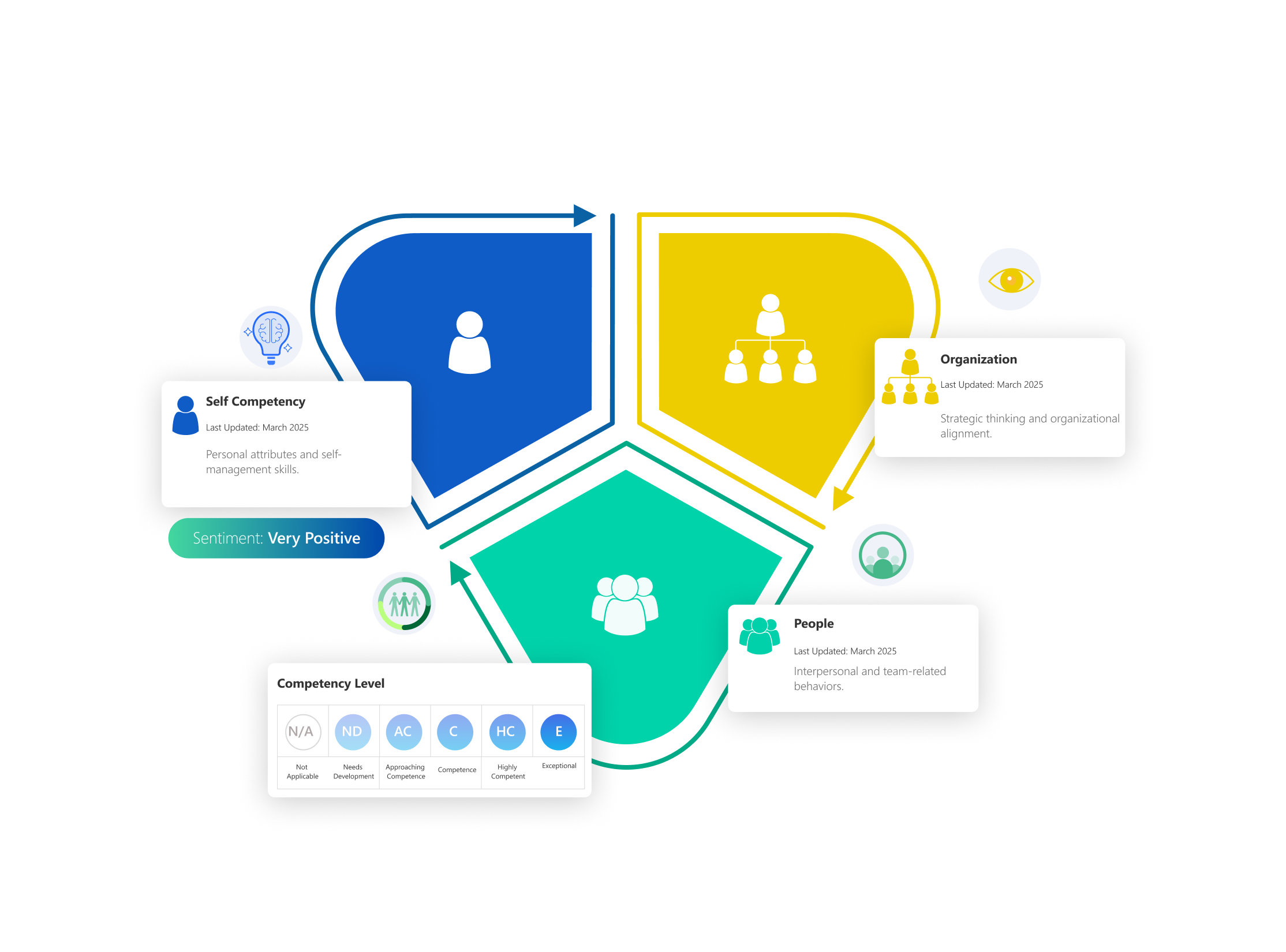-
REAL IMPACT
Competency models are not merely HR tools; they are strategic frameworks that drive accountability, performance, and enterprise growth.
Increased Individual and Team Performance
Aligning roles with clear behavioral and technical competencies ensures employees perform with focus, clarity, and accountability.
Streamlined Talent Development
Targeted development plans based on competency gaps eliminate generic training and focus investments on high-impact areas.
Better Hiring and Role Alignment
Hiring against a defined competency framework ensures better fit and readiness for role demands.
Advantages of the High Performance Competency Model
Empower your workforce decisions with in-depth, data-driven talent assessments designed
to uncover potential, align capabilities.
to uncover potential, align capabilities.
KBI's
Key Behavioral Indicators (KBIs) provide a more precise definition of expectations.
Written content
Content is written to ensure simplicity and ease of understanding.
Select your own competencies
Select the appropriate combination of competencies by role and/or level.
Behaviorally-anchored scales
Behaviorally-anchored scales that research shows leads to more effective and accurate feedback.
Multi-Method
Multi-method is best! Talent MAP groups insights from different sources.
Talent Benchmarking Projects
Talent Benchmarking Projects to explore and research the talent metrics within your enterprise.
Three Dimensions of
Competency

Having a consistent framework is crucial, especially when developing competencies so that they are observable and measurable. That’s where the Mentis High Performance Competency Model (HPCM) comes in.
The HPCM is based on rigorous scientific research and expert opinion, and it captures the attitudes, behaviors, and knowledge necessary for high performance. What’s unique about this model is its ability to cater to people from all backgrounds and the care taken in ensuring it’s future-proof and culturally sensitive. It achieves this by using accessible, everyday language that anyone can understand.
As a result, the HPCM helps individuals and organizations alike understand the essential competencies needed for success and taking action on these more easily. This ensures that everyone is on the same page, making it easier to work together towards achieving goals.
The HPCM is based on rigorous scientific research and expert opinion, and it captures the attitudes, behaviors, and knowledge necessary for high performance. What’s unique about this model is its ability to cater to people from all backgrounds and the care taken in ensuring it’s future-proof and culturally sensitive. It achieves this by using accessible, everyday language that anyone can understand.
As a result, the HPCM helps individuals and organizations alike understand the essential competencies needed for success and taking action on these more easily. This ensures that everyone is on the same page, making it easier to work together towards achieving goals.
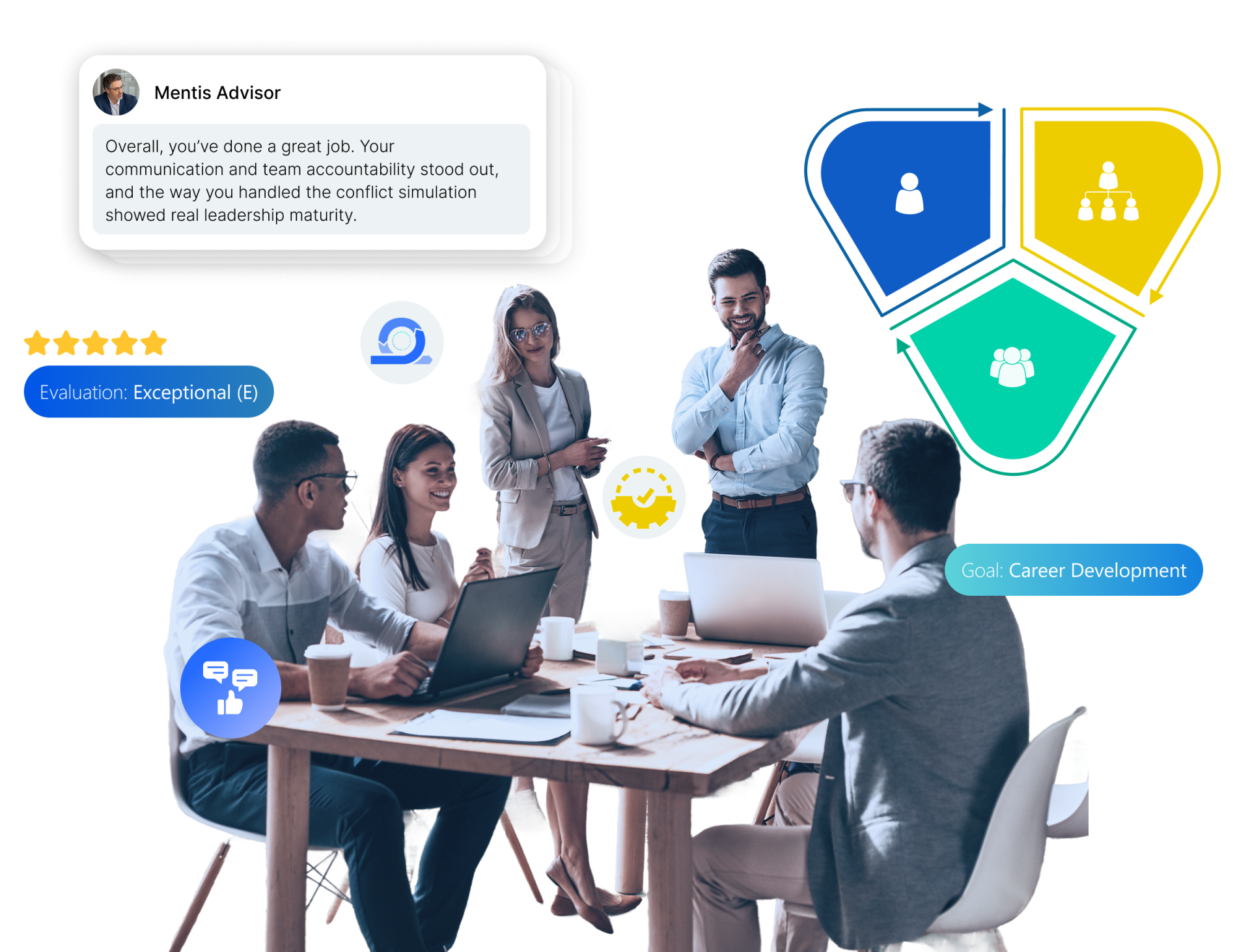
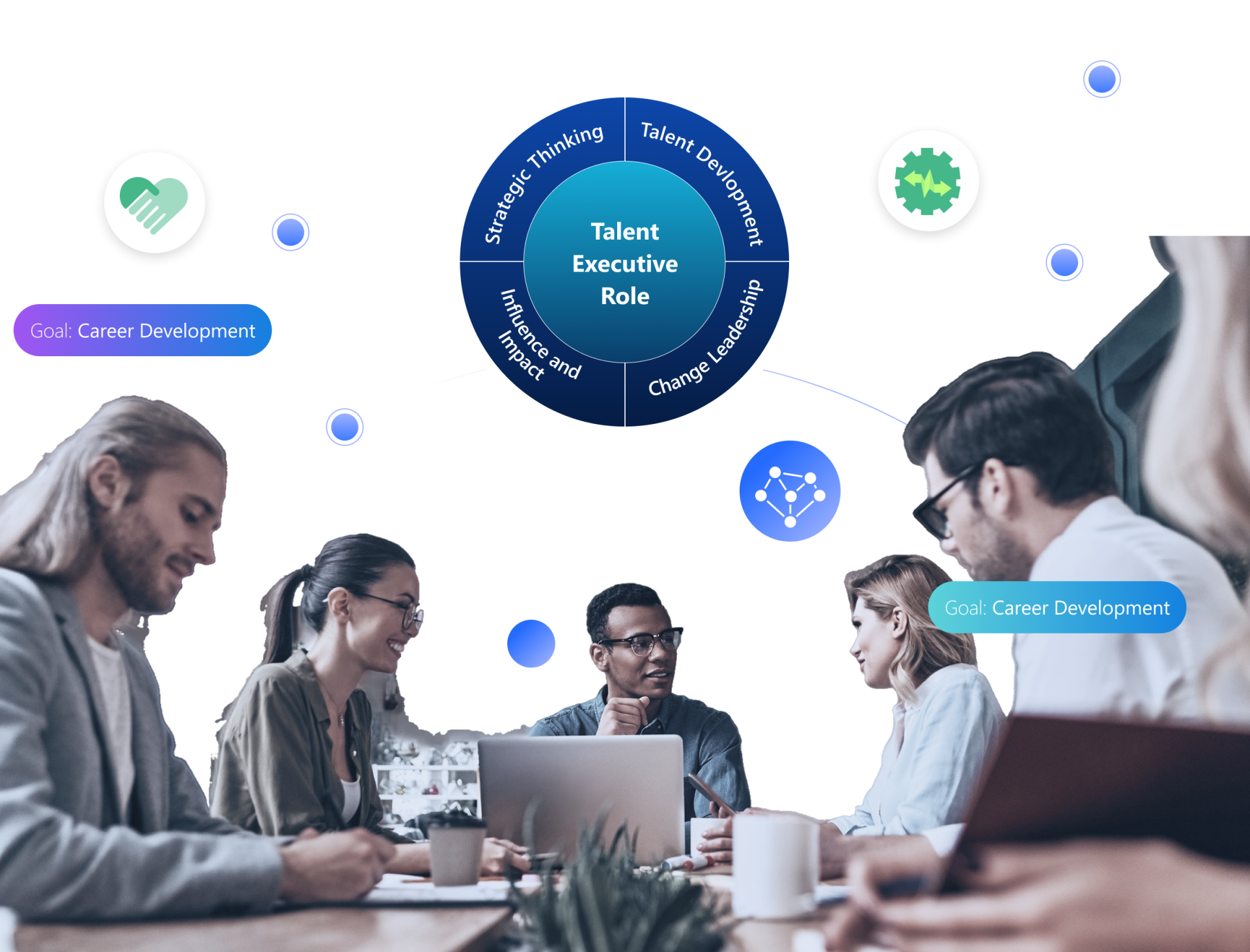
Navigating to Success: Mapping the Key Competencies for Job Performance
In the modern workplace, determining which attitudes, behaviors, and knowledge are essential for success can be challenging. It’s easy to identify underperforming employees, but it’s often difficult to understand the root cause of their struggles. On the other hand, it can be even more challenging to differentiate between good and excellent performers, as the differences are often subtle but critical.
- It’s essential to identify the strengths and weaknesses of each individual’s competencies to ensure they are matched to the role they’re in. When there’s a mismatch, it leads to disengagement and negatively impacts the individual’s development journey, regardless of their intent.
- This can contribute to a difficult environment for both the individual and the organization, leading to dissatisfaction and turnover. That’s why it’s crucial for businesses to invest in tools and frameworks that help identify the essential competencies for success and ensure that individuals are matched to the right roles. By doing so, companies can create a positive work environment that drives engagement, job satisfaction, and ultimately, long-term success.
An Overview of the Model
The Mentis High Performance Competency Model (HPCM) focuses on
attitudes, behaviors and knowledge that are observable and measurable.
attitudes, behaviors and knowledge that are observable and measurable.
Self Competencies
People Competencies
Organizational Competencies
Self Competencies
Ability to manage oneself through accountability, adaptability, and continuous growth.
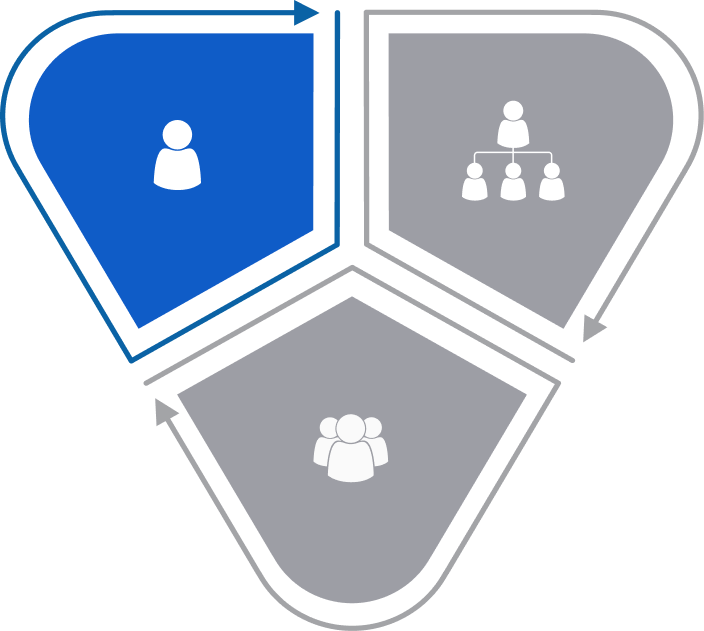
Integrity
Establishes trust with colleagues by being honest and principled. Is appropriately transparent with co-workers. Respects others’ privacy and keeps sensitive information confidential.
Analytical Thinking
Ability to break down problems, identify complex relationships and critically interpret them; leading to solutions.
Self-confidence
Displays appropriate self-assurance and determination. Voices their opinions and ideas confidently, willing to challenge others.
Drive
Recognizes organizational goals and aspirations and identifies how to achieve them, taking action without instruction.
Integrity
Establishes trust with colleagues by being honest and principled. Is appropriately transparent with co-workers. Respects others’ privacy and keeps sensitive information confidential.
Analytical Thinking
Ability to break down problems, identify complex relationships and critically interpret them; leading to solutions.
Self-confidence
Displays appropriate self-assurance and determination. Voices their opinions and ideas confidently, willing to challenge others.
Drive
Recognizes organizational goals and aspirations and identifies how to achieve them, taking action without instruction.
Learning Agility
Continuously looking out for opportunities to learn and self-improve. They are keen to embark on novel experiences, are mentally flexible and view mistakes as valuable opportunities to grow.
Optimism
Displays interest and excitement about their work. Identifies with and participates in challenging tasks with optimism and passion.
Adaptability
Easily readjusts and modifies their behavior in novel situations and based on current demands at work.
Accountability
Acts professionally and takes responsibility for their decisions and actions. Is methodical and organized and can be trusted to deliver results at a timely manner.
Learning Agility
Continuously looking out for opportunities to learn and self-improve. They are keen to embark on novel experiences, are mentally flexible and view mistakes as valuable opportunities to grow.
Optimism
Displays interest and excitement about their work. Identifies with and participates in challenging tasks with optimism and passion.
Adaptability
Easily readjusts and modifies their behavior in novel situations and based on current demands at work.
Accountability
Acts professionally and takes responsibility for their decisions and actions. Is methodical and organized and can be trusted to deliver results at a timely manner.
Creative Thinking
Uses their imagination and ability to invent for the benefit of the organization. Critically assesses the quality of own and others’ ideas and improves upon them using their creativity.
Attention to detail
Performs tasks while recognizing the significance of detail and quality. Is thorough and accurate with work output, identifying and correcting errors.
Delivering Results
Achieves their goals and produces high quality work by remaining motivated and focused when overcoming obstacles.
Resilience
Maintains composure by recognizing their thoughts, emotions and behavior. Demonstrates the ability to overcome disappointments and to succeed in challenging situations. Maintains a healthy balance between life and work.
Creative Thinking
Uses their imagination and ability to invent for the benefit of the organization. Critically assesses the quality of own and others’ ideas and improves upon them using their creativity.
Attention to detail
Performs tasks while recognizing the significance of detail and quality. Is thorough and accurate with work output, identifying and correcting errors.
Delivering Results
Achieves their goals and produces high quality work by remaining motivated and focused when overcoming obstacles.
Resilience
Maintains composure by recognizing their thoughts, emotions and behavior. Demonstrates the ability to overcome disappointments and to succeed in challenging situations. Maintains a healthy balance between life and work.
Decision Making
Identifies possible solutions to manage problems effectively and efficiently by using good judgement when weighing up potential positive and negative implications. When faced with important decisions they do not hesitate to act.
Capability to Perform
Possesses a strong and effective capability in their role using the key skills and knowledge necessary to succeed.
Decision Making
Identifies possible solutions to manage problems effectively and efficiently by using good judgement when weighing up potential positive and negative implications. When faced with important decisions they do not hesitate to act.
Capability to Perform
Possesses a strong and effective capability in their role using the key skills and knowledge necessary to succeed.
Digital Competencies
Digital Awareness
Identifies opportunities or needs to use digital technology by staying aware of trends, challenges, and new possibilities. Takes initiative to explore innovative digital solutions that improve personal or team effectiveness.
Digital Proficiency
Demonstrates the ability to confidently use, adapt, and apply digital tools and processes to complete tasks, solve problems, and improve personal or team workflows. Focuses on effectively mastering tools and processes and quickly learning new digital solutions.
Digital Responsibility
Applies sound judgment when using digital tools, considering ethical and responsible use. Balances the benefits of digital technology with potential risks, ensuring decisions align with personal and professional standards.
Digital Awareness
Identifies opportunities or needs to use digital technology by staying aware of trends, challenges, and new possibilities. Takes initiative to explore innovative digital solutions that improve personal or team effectiveness.
Digital Proficiency
Demonstrates the ability to confidently use, adapt, and apply digital tools and processes to complete tasks, solve problems, and improve personal or team workflows. Focuses on effectively mastering tools and processes and quickly learning new digital solutions.
Digital Responsibility
Applies sound judgment when using digital tools, considering ethical and responsible use. Balances the benefits of digital technology with potential risks, ensuring decisions align with personal and professional standards.
People Competencies
Capacity to collaborate, communicate, and build positive, productive relationships.
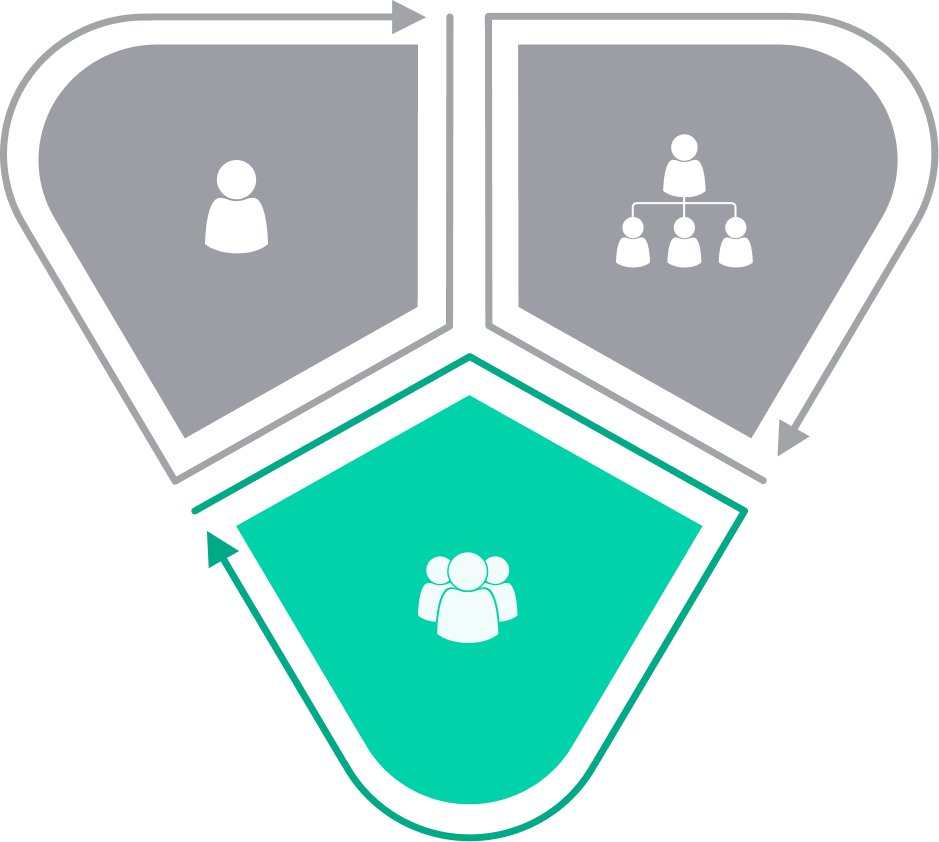
Assertiveness
Capacity to appropriately assert own ideas and opinions and those of others. Willing to support and challenge other people in a constructive and inclusive manner, defending what appears to be right. Demonstrates an appropriate level of confidence in their own abilities.
Sensitivity to Others
Shows empathy and understanding for the reactions and choices of others and responds in an appropriate way. Enables the building of effective trusted relationships with people.
Building Teams
Brings the right people together to form a high-performing team at the right time to achieve organizational goals.
Diversity Mindset
Understands and appreciates diversity in people, values and cultures. Recognizes the important of and creates an inclusive environment where people of different abilities and backgrounds can thrive. Respects social customs and expectations.
Assertiveness
Capacity to appropriately assert own ideas and opinions and those of others. Willing to support and challenge other people in a constructive and inclusive manner, defending what appears to be right. Demonstrates an appropriate level of confidence in their own abilities.
Sensitivity to Others
Shows empathy and understanding for the reactions and choices of others and responds in an appropriate way. Enables the building of effective trusted relationships with people.
Building Teams
Brings the right people together to form a high-performing team at the right time to achieve organizational goals.
Diversity Mindset
Understands and appreciates diversity in people, values and cultures. Recognizes the important of and creates an inclusive environment where people of different abilities and backgrounds can thrive. Respects social customs and expectations.
Motivating Others
helps others to set a vision for goals and outcomes. Adapts motivational style based on individual needs and goals. Provides timely, constructive feedback to others to increase confidence. Encourages others to put sustained effort into achieving their goals and objectives.
Communication
Ability to actively listen and express oneself clearly and effectively through verbal and non-verbal communication channels to one or groups of individuals.
Customer Focus
Orientation towards serving and satisfying client’s needs and expectations.
Developing People
Recognizes potential in others and provides learning opportunities including mentoring and timely feedback on progress towards developmental goals and growth.
Motivating Others
helps others to set a vision for goals and outcomes. Adapts motivational style based on individual needs and goals. Provides timely, constructive feedback to others to increase confidence. Encourages others to put sustained effort into achieving their goals and objectives.
Communication
Ability to actively listen and express oneself clearly and effectively through verbal and non-verbal communication channels to one or groups of individuals.
Customer Focus
Orientation towards serving and satisfying client’s needs and expectations.
Developing People
Recognizes potential in others and provides learning opportunities including mentoring and timely feedback on progress towards developmental goals and growth.
Respect for Others
Respects all people, accepting individual differences, viewing and treating others consistently with fairness and without favoritism.
Conflict Resolution
Recognizes and acknowledged signs of a conflict situation, and promotes open-minded cooperation. Listens and makes effort to help others understand opposing viewpoints and works to resolve conflict in a positive, fair, and tactful way.
Leading Performance
Supports others in achieving a high level of performance. Tracks progress and gives feedback to ensure that organizational goals are met. Ensures accountability for performance.
Collaboration
Maintains positive and productive relationships by working effectively with others towards a common mission, values and goals. Shares knowledge and information with others and considers their contributions.
Respect for Others
Respects all people, accepting individual differences, viewing and treating others consistently with fairness and without favoritism.
Conflict Resolution
Recognizes and acknowledged signs of a conflict situation, and promotes open-minded cooperation. Listens and makes effort to help others understand opposing viewpoints and works to resolve conflict in a positive, fair, and tactful way.
Leading Performance
Supports others in achieving a high level of performance. Tracks progress and gives feedback to ensure that organizational goals are met. Ensures accountability for performance.
Collaboration
Maintains positive and productive relationships by working effectively with others towards a common mission, values and goals. Shares knowledge and information with others and considers their contributions.
Influencing & Persuasion
Recognizes others’ opinion or position and considers this in efforts to influence or persuade. Uses their skills and style to convince others to change their attitudes, thoughts or actions, with the intention to achieve positive change or benefit.
Negotiation
Plans in advance of negotiations. Builds rapport effectively when negotiating and seeks to understand all parties’’ positions appropriately communicates intentions and desired outcomes, settling disagreement with a common resolution that is beneficial to everyone.
Influencing & Persuation
Recognizes others’ opinion or position and considers this in efforts to influence or persuade. Uses their skills and style to convince others to change their attitudes, thoughts or actions, with the intention to achieve positive change or benefit.
Negotation
Plans in advance of negotiations. Builds rapport effectively when negotiating and seeks to understand all parties’’ positions appropriately communicates intentions and desired outcomes, settling disagreement with a common resolution that is beneficial to everyone.
Digital Competency
Drives Digital Adaptation
Encourages and motivates others to embrace digital tools, processes, or solutions by building understanding, enthusiasm, and gaining buy-in. Effectively communicates the benefits of digital adoption, addresses concerns, and fosters collaboration across teams and stakeholders to ensure smooth implementation and acceptance of digital technologies.
Drives Digital Adaptation
Encourages and motivates others to embrace digital tools, processes, or solutions by building understanding, enthusiasm, and gaining buy-in. Effectively communicates the benefits of digital adoption, addresses concerns, and fosters collaboration across teams and stakeholders to ensure smooth implementation and acceptance of digital technologies.
Organizational Competencies
Capability to align with goals, drive results, and contribute to overall success.
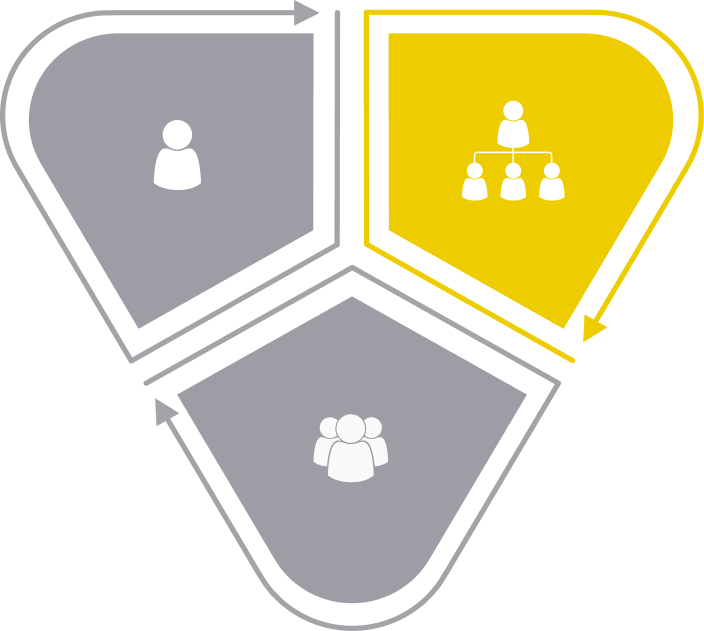
Organization Awareness
Awareness and understanding of an organization’s politics, culture, distribution of power and influence as well as using this ability to achieve organizational objectives.
Operational Excellence
Execution of the organizational plans and strategy, managing operational risk, monitoring process improvement, and ensuring consistent quality of processes and outputs.
Strategic Orientation
Establishes plans for the long-term aligning the organization with expected future contexts and requirements. Recognizes and integrates pioneering ideas and approaches to strategic decision making.
Financial Proficiency
Knowledge and expertise in financial topics required for their role. Understands and applies e.g. budgeting, reporting and forecasting, drivers for profitability or efficiency, in a proficient way. Makes fiscally prudent decisions that are beneficial to the business or organization.
Organization Awareness
Awareness and understanding of an organization’s politics, culture, distribution of power and influence as well as using this ability to achieve organizational objectives.
Operational Excellence
Execution of the organizational plans and strategy, managing operational risk, monitoring process improvement, and ensuring consistent quality of processes and outputs.
Strategic Orientation
Establishes plans for the long-term aligning the organization with expected future contexts and requirements. Recognizes and integrates pioneering ideas and approaches to strategic decision making.
Financial Proficiency
Knowledge and expertise in financial topics required for their role. Understands and applies e.g. budgeting, reporting and forecasting, drivers for profitability or efficiency, in a proficient way. Makes fiscally prudent decisions that are beneficial to the business or organization.
External Awareness
Possesses an appropriate understanding of the context in which the organization operates and applies this knowledge to influence and guide actions. This may include relevant political, cultural, economic, human, ecological, technological, consumer, legal, health and social issues.
Leading Change
Identifies opportunities for change in the organization. Is willing to take risks to improve the organization by evaluating and managing change. Helps implement change effectively by creating an organizational culture that is supportive and adaptive in embracing transformation.
Network & Stakeholder Engagement
Cultivates environments that encourage collaborative networking practices. Understands and engages with stakeholder expectations effectively. Recognizes networking opportunities and builds strategic alliances with internal and external individuals and organizations.
Sustainability
Influences the economic, environmental and social purpose of the organization within its external environment. Works towards ensuring organizational continuity through sustainable management practices and preserving resources. Empowers and rewards others to make choices and decisions to delver sustainability, including processes to monitor success.
External
Awareness
Possesses an appropriate understanding of the context in which the organization operates and applies this knowledge to influence and guide actions. This may include relevant political, cultural, economic, human, ecological, technological, consumer, legal, health and social issues.
Leading
Change
Identifies opportunities for change in the organization. Is willing to take risks to improve the organization by evaluating and managing change. Helps implement change effectively by creating an organizational culture that is supportive and adaptive in embracing transformation.
Network & Stakeholder
Engagement
Cultivates environments that encourage collaborative networking practices. Understands and engages with stakeholder expectations effectively. Recognizes networking opportunities and builds strategic alliances with internal and external individuals and organizations.
Sustainability
Influences the economic, environmental and social purpose of the organization within its external environment. Works towards ensuring organizational continuity through sustainable management practices and preserving resources. Empowers and rewards others to make choices and decisions to delver sustainability, including processes to monitor success.
Create Shared Vision
Communicates strategy and vision to colleagues. Inspires others to strive towards collective organizational goals and a common mission.
Create Shared Vision
Communicates strategy and vision to colleagues. Inspires others to strive towards collective organizational goals and a common mission.
Digital Competency
Leads Digital Transformation
Leads and drives organizational digital transformation initiatives by developing a compelling vision, designing well-integrated plans that consider organizational complexities and conflicts, ensuring successful execution of transformation strategies, and fostering a sustainable culture of digital transformation across the enterprise to deliver long-term impact and measurable results.
Leads Digital Transformation
Leads and drives organizational digital transformation initiatives by developing a compelling vision, designing well-integrated plans that consider organizational complexities and conflicts, ensuring successful execution of transformation strategies, and fostering a sustainable culture of digital transformation across the enterprise to deliver long-term impact and measurable results.
Case Studies
See how brands use talent evaluation to craft insightful, unforgettable guest experience.

Talent evaluation is the process of assessing individuals to determine their abilities, potential, performance, and fit for a particular role, team, or organization. It’s a critical function in talent management and is often used in hiring, promotions, leadership development, succession planning, and team building.
Empty space, drag to resize

Talent evaluation is the process of assessing individuals to determine their abilities, potential, performance, and fit for a particular role, team, or organization. It’s a critical function in talent management and is often used in hiring, promotions, leadership development, succession planning, and team building.
Empty space, drag to resize

Talent evaluation is the process of assessing individuals to determine their abilities, potential, performance, and fit for a particular role, team, or organization. It’s a critical function in talent management and is often used in hiring, promotions, leadership development, succession planning, and team building.
Empty space, drag to resize

Talent evaluation is the process of assessing individuals to determine their abilities, potential, performance, and fit for a particular role, team, or organization. It’s a critical function in talent management and is often used in hiring, promotions, leadership development, succession planning, and team building.
Empty space, drag to resize

Talent evaluation is the process of assessing individuals to determine their abilities, potential, performance, and fit for a particular role, team, or organization. It’s a critical function in talent management and is often used in hiring, promotions, leadership development, succession planning, and team building.
Empty space, drag to resize

See Who’s Driving Impact in your Network
Frequently Asked Questions
What is the Mentis High Performance Competency Model (HPCM)?
A research-led framework of 40+ behavioral and technical competencies that define the observable behaviors linked to high performance. Each competency includes levelled behavioral indicators so you can match expectations to role seniority.
How is the model structured?
Competencies are organized into domains that cover Self, People, and Organization. Within each, behaviors are defined across levels (e.g., specialist, manager, senior leader) so progression is transparent and fair.
Where can we use the HPCM?
Across the talent lifecycle: role design, job profiles, selection (CBI), assessment (Navigator 90/180/360), development planning, learning journeys, succession, and performance reviews.
How does it connect to Mentis tools?
HPCM is the backbone for Mentis Navigator feedback, competency-based interviews, business simulations, and individual development plans; so evidence from different methods maps to the same competency language.
Is the model validated?
Yes. The HPCM draws on peer-reviewed research, occupational psychology standards, and multi-year program data. We continuously review indicators for clarity, reliability, and job relevance.
Can we tailor the model to our organization?
Absolutely. Keep the core architecture and customize emphasis, role profiles, and exemplars. We can also map your values or leadership principles to HPCM competencies.
What does implementation look like?
A short discovery to align roles and outcomes, a mapping workshop, activation in Navigator (90/180/360-degree feedback), interviewer training for CBI, and development planning toolkits for managers and participants.
How long does it take to get started?
Most clients pilot within weeks: beginning with 3–6 priority roles, then scale to functions or enterprise.
How is pricing structured?
Flexible packages by cohort size and modules (assessment, development, certification). Discounts for multi-year programs and enterprise subscriptions.
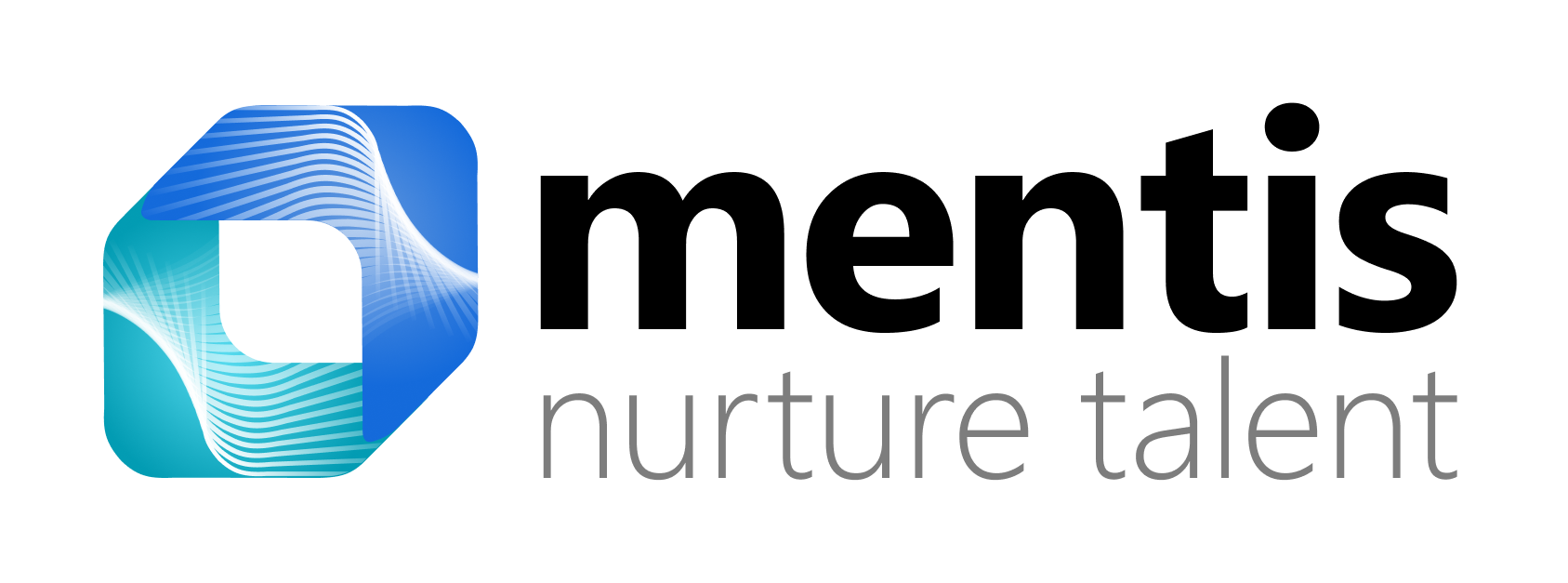
Empty space, drag to resize
Stay Updated on Talent Innovation, Events & Product Launches
By providing this information, you agree that we may process your personal data in accordance with our Privacy Statement.
-
Resources
-
Insights
-
Partners
-
Success Stories
Request a demo
By providing this information, you agree that we may process your personal data in accordance with our Privacy Statement.
Richard Brady is the Founder & Executive Chairman of Mentis Talent Technologies, a Singapore‑headquartered HR EdTech company operating across EMEA and Asia-Pac. He has devoted 35 years to building high‑impact, evidence‑based approaches to talent evaluation, insight, and learning. Richard established Mentis in 2003 with a simple premise: organizations thrive when they nurture talent, not just measure it. Today, that ethos is embodied in the Mentis Navigator ecosystem: OCEANS Personality Navigator, Competency Navigator 90/180/360-degree feedback, SONAR Network Centrality, and the BRAVO Social‑Emotional Compass, providing a coherent, data‑rich pathway from insight to action.
Richard’s client work spans the public and private sectors across the GCC and ASEAN. He has designed and led multi‑method leadership programs, combining competency‑based interviews, multi‑source feedback, business simulations, and Hogan personality & reasoning assessment. Mentis programs emphasize measurable business outcomes, capability uplift, and the creation of collaborative learning cohorts supported by mentoring and feedback. Mentis has supported hundreds of multinational companies, NGOs, and regional entities in the GCC with talent evaluation and development programs.
Richard is a trained and certified coach, Situational Leadership® certified practitioner and highly experienced coach and mentor for specialists and leadership navigating career transitions and promotions.
A Chartered Occupational Psychologist (HCPC‑registered; BPS Chartered), Richard has trained and certified thousands of practitioners in personality assessment and evidence‑based talent practices. He is Hogan‑certified (HPI, HDS, MVPI; advanced interpretation) and experienced facilitator multisource feedback. He has partnered as adjunct faculty or facilitator with leading business schools including London Business School, Oxford Saïd, IMD, and Thunderbird.
Richard’s academic work focuses on psychological flexibility (ACT/fACT) and social‑emotional learning at work. As a doctoral researcher at Goldsmiths, University of London (Institute of Management Studies), he is conducting mixed‑methods research exploring how psychological flexibility relates to quality of working life, values‑based action, and leadership development, integrating RCTs, systematic reviews (PRISMA‑aligned). These insights inform Mentis Navigator product design and coaching‑at‑scale methodologies.
Beyond assessment, Richard champions competency development as an organizational capability. He designs journeys that help leaders optimize strengths and neutralize derailers, blending focused practice, mentoring feedback, and network‑centric development through SONAR. His coaching draws on Acceptance & Commitment Training (fACT), compassion‑focused approaches, and solution‑focused models aligned to EMCC/ICF standards, translating science into practical behavior change.
Richard divides his time between product strategy, client advisory, and research, with a growing emphasis on thought leadership and practitioner accreditation through Mentis Academy. He is committed to building an inclusive, data‑literate coaching community across ASEAN and the GCC and to advancing prosocial, values‑based leadershi true to the Mentis promise: Nurture Talent™.
Richard’s client work spans the public and private sectors across the GCC and ASEAN. He has designed and led multi‑method leadership programs, combining competency‑based interviews, multi‑source feedback, business simulations, and Hogan personality & reasoning assessment. Mentis programs emphasize measurable business outcomes, capability uplift, and the creation of collaborative learning cohorts supported by mentoring and feedback. Mentis has supported hundreds of multinational companies, NGOs, and regional entities in the GCC with talent evaluation and development programs.
Richard is a trained and certified coach, Situational Leadership® certified practitioner and highly experienced coach and mentor for specialists and leadership navigating career transitions and promotions.
A Chartered Occupational Psychologist (HCPC‑registered; BPS Chartered), Richard has trained and certified thousands of practitioners in personality assessment and evidence‑based talent practices. He is Hogan‑certified (HPI, HDS, MVPI; advanced interpretation) and experienced facilitator multisource feedback. He has partnered as adjunct faculty or facilitator with leading business schools including London Business School, Oxford Saïd, IMD, and Thunderbird.
Richard’s academic work focuses on psychological flexibility (ACT/fACT) and social‑emotional learning at work. As a doctoral researcher at Goldsmiths, University of London (Institute of Management Studies), he is conducting mixed‑methods research exploring how psychological flexibility relates to quality of working life, values‑based action, and leadership development, integrating RCTs, systematic reviews (PRISMA‑aligned). These insights inform Mentis Navigator product design and coaching‑at‑scale methodologies.
Beyond assessment, Richard champions competency development as an organizational capability. He designs journeys that help leaders optimize strengths and neutralize derailers, blending focused practice, mentoring feedback, and network‑centric development through SONAR. His coaching draws on Acceptance & Commitment Training (fACT), compassion‑focused approaches, and solution‑focused models aligned to EMCC/ICF standards, translating science into practical behavior change.
Richard divides his time between product strategy, client advisory, and research, with a growing emphasis on thought leadership and practitioner accreditation through Mentis Academy. He is committed to building an inclusive, data‑literate coaching community across ASEAN and the GCC and to advancing prosocial, values‑based leadershi true to the Mentis promise: Nurture Talent™.
Professional Profile
Founder & Executive Chairman, Mentis Talent Technologies (since 2003) - Executive Coach & Program Architect (lead evaluator, assessor, and mentor) - Researcher (Goldsmiths, University of London).
What I Do - Design and lead multi‑method leadership evaluation & development programs - Build data‑rich learning journeys that integrate assessment, mentoring, and practice - Advise boards and CHROs on successor pipelines, capability models, and cohort scaling
Domains - Talent Evaluation & Insight • Competency Frameworks • Multi‑source Feedback (90/180/360) • Business Simulations • Personality & Reasoning Assessment • Social‑Emotional Learning • Network‑centric Development • Coaching at Scale
What I Do - Design and lead multi‑method leadership evaluation & development programs - Build data‑rich learning journeys that integrate assessment, mentoring, and practice - Advise boards and CHROs on successor pipelines, capability models, and cohort scaling
Domains - Talent Evaluation & Insight • Competency Frameworks • Multi‑source Feedback (90/180/360) • Business Simulations • Personality & Reasoning Assessment • Social‑Emotional Learning • Network‑centric Development • Coaching at Scale
Signature Programs & Systems
- Mentis Navigator™ Ecosystem:
- OCEANS Personality Navigator (trait profiledevelopment narratives, strengths/risks)
- Competency Navigator 90/180/360 (multisource feedback with Observed‑Interpretive reporting)
- SONAR Network Centrality (mapping collaborative influence and learning networks)
- BRAVO Social‑Emotional Compass (SEL insights for professionals)
- Career Anchors (career drivers and development alignment)
- Learning Journeys: Cohort‑based development with mentoring & focused ACT‑informed practice
- Assessment & Development Centers: Competency‑based interviews, simulations, reasoning tests, and personality profiling for integrated, powerful insights and individual development planning.
Accreditations & Professional Standards
- Chartered Occupational Psychologist (HCPC‑registered – Board Certified; BPS Chartered). BPS RQTU Qualified Assessor.
- Hogan Assessments: HPI, HDS, MVPI; Advanced Interpretation Facilitator (2003 to 2020.
- Multi‑source feedback systems (90/180/360-degree feedback) and competency‑based interviewing and development planning
Speaking & Teaching
Keynotes, executive education, and practitioner training on:
- Psychological flexibility & prosocial leadership
- Competency‑based assessment and
- Observed‑Interpretive reporting
- Scaling mentoring and cohort‑based learning with data
- Navigating derailers and decision‑making under uncertainty

Haris Ali Akbar
Talent Consultant
Haris is a Talent Consultant at Mentis Global, focusing on corporate and executive talent assessments to support succession planning, high-potential mapping, and hiring decisions. In his first year specializing in assessment, he designs and delivers programs that integrate behavioral interviews, business simulations, and psychometric tools to help organizations make evidence-based talent decisions. Drawing on his strong foundation in people development, Haris brings depth to interpreting assessment results and evaluating employee competencies beyond surface-level performance.
Before moving into assessment, Haris spent over five years in learning and development, specializing in soft skills such as leadership, innovation, and communication. His extensive experience designing capability programs and facilitating corporate development and innovation initiatives gives him a developmental lens in assessment work, enabling sharp identification of both strengths and growth opportunities.
Haris is also a professional coach who has achieved ICF Associate Certified Coach (ACC) level, supporting individuals in leadership, career development, and corporate innovation contexts. He is also a candidate for a Master’s in Applied Human Resource Psychology at the University of Indonesia, where his research explores the intersection of personality and learning behavior in the workplace to bridge psychological science and organizational practice.
Before moving into assessment, Haris spent over five years in learning and development, specializing in soft skills such as leadership, innovation, and communication. His extensive experience designing capability programs and facilitating corporate development and innovation initiatives gives him a developmental lens in assessment work, enabling sharp identification of both strengths and growth opportunities.
Haris is also a professional coach who has achieved ICF Associate Certified Coach (ACC) level, supporting individuals in leadership, career development, and corporate innovation contexts. He is also a candidate for a Master’s in Applied Human Resource Psychology at the University of Indonesia, where his research explores the intersection of personality and learning behavior in the workplace to bridge psychological science and organizational practice.

Myles Empacis
Full-stuck Developer
Lorem Ipsum is simply dummy text of the printing and typesetting industry. Lorem Ipsum has been the industry's standard dummy text ever since the 1500s, when an unknown printer took a galley of type and scrambled it to make a type specimen book. It has survived not only five centuries, but also the leap into electronic typesetting, remaining essentially unchanged. It was popularised in the 1960s with the release of Letraset sheets containing Lorem Ipsum passages, and more recently with desktop publishing software like Aldus PageMaker including versions of Lorem Ipsum.
Lorem Ipsum is simply dummy text of the printing and typesetting industry. Lorem Ipsum has been the industry's standard dummy text ever since the 1500s, when an unknown printer took a galley of type and scrambled it to make a type specimen book. It has survived not only five centuries, but also the leap into electronic typesetting, remaining essentially unchanged. It was popularised in the 1960s with the release of Letraset sheets containing Lorem Ipsum passages, and more recently with desktop publishing software like Aldus PageMaker including versions of Lorem Ipsum.
Lorem Ipsum is simply dummy text of the printing and typesetting industry. Lorem Ipsum has been the industry's standard dummy text ever since the 1500s, when an unknown printer took a galley of type and scrambled it to make a type specimen book. It has survived not only five centuries, but also the leap into electronic typesetting, remaining essentially unchanged. It was popularised in the 1960s with the release of Letraset sheets containing Lorem Ipsum passages, and more recently with desktop publishing software like Aldus PageMaker including versions of Lorem Ipsum.
Are you sure you want to sign out?
You will be signed out of your account and need to log in again to continue.
log in
Not a member yet? Create a free profile by taking our personality test or entering your results yourself.
Richard Overy (“RO”) is a seasoned business transformation executive and leadership consultant with over 25 years of experience at the C-suite level, specializing in customer service, leadership development, and operational excellence. His expertise spans project coordination, business relationship management, and customer satisfaction, with extensive experience across multiple industries, including Travel & Tourism, Financial Services, IT & Professional Services, Telecommunications, FinTech, Utilities, Public Sector, Engineering, and Healthcare. He has led numerous large-scale M&A, MBO, and business transformation initiatives across Europe, EMEA, BRIC, and North America. His strategic advisory work focuses on aligning strategy, culture, and leadership to drive performance and business growth.
Richard is a Principal Consultant at Mentis (since February 2023), where he leads talent evaluation, survey methodologies, and leadership development initiatives. He implements Mentis talent profiling and development solutions to enhance leadership and specialist interpersonal, and self-awareness and utilizes Competency Navigator to align recruitment, performance management, and succession planning with business strategy. His work ensures that talent development efforts drive long-term organizational success through data-driven insights and structured development programs.
In addition to his role at Mentis, Richard holds several consulting, training, and development roles, contributing his expertise across global organizations:
Across these roles, Richard advises businesses on leadership development, cultural transformation, customer experience strategies, and operational improvements, delivering customized training programs and mentoring executives in strategic growth and change management.
Previously, Richard held key executive positions, including:
Managing Director, Phonetics (UK) Ltd (2003-2005)
Group IT & Operations Director, Hoseasons Holidays Group (1979-2003)
His substantial experience in business strategy, customer service excellence, and digital transformation has made him a trusted advisor in optimizing talent, operations, and leadership effectiveness on a global scale.
Business Experience
Richard’s extensive consulting and leadership experience covers a range of industries and international markets. He has successfully designed and delivered customer service strategies, executive coaching programs, cultural transformation projects, and IT system integrations for a wide range of clients.
His key consulting projects include:
Qualifications, Certifications
Richard has 30+ years of experience in leadership development and executive mentoring, specializing in aligning people development programs with business objectives.
Personal Philosophy"I believe that success in business transformation is achieved through people. Effective leadership is about fostering the right culture, developing talent, and aligning business strategy with employee engagement. Whether it’s driving customer service excellence, coaching executives, or implementing large-scale business change, I am committed to helping organizations achieve sustainable growth through strategic leadership, process optimization, and people development."
Other Interests Richard is an active mentor and advisor who enjoys contributing to leadership and business transformation discussions. When he is not consulting or training, he spends time traveling, engaging in business networking, and staying updated on the latest trends in technology and digital transformation.
Richard is a Principal Consultant at Mentis (since February 2023), where he leads talent evaluation, survey methodologies, and leadership development initiatives. He implements Mentis talent profiling and development solutions to enhance leadership and specialist interpersonal, and self-awareness and utilizes Competency Navigator to align recruitment, performance management, and succession planning with business strategy. His work ensures that talent development efforts drive long-term organizational success through data-driven insights and structured development programs.
In addition to his role at Mentis, Richard holds several consulting, training, and development roles, contributing his expertise across global organizations:
- Project Director / Lead Consultant / Trainer / Mentor, Senex Consulting (2005 – Present)
- Senior Consultant, Faze 3 Consulting (2022 – Present)
- Partner, Konsälidön (2019 – Present)
- Trainer, Mercuri International Group (2005 – Present)
Across these roles, Richard advises businesses on leadership development, cultural transformation, customer experience strategies, and operational improvements, delivering customized training programs and mentoring executives in strategic growth and change management.
Previously, Richard held key executive positions, including:
Managing Director, Phonetics (UK) Ltd (2003-2005)
Group IT & Operations Director, Hoseasons Holidays Group (1979-2003)
His substantial experience in business strategy, customer service excellence, and digital transformation has made him a trusted advisor in optimizing talent, operations, and leadership effectiveness on a global scale.
Business Experience
Richard’s extensive consulting and leadership experience covers a range of industries and international markets. He has successfully designed and delivered customer service strategies, executive coaching programs, cultural transformation projects, and IT system integrations for a wide range of clients.
His key consulting projects include:
- Muscat, Oman: Led sales and soft-skills training programs for a major regional bank in compliance with regulatory standards.
- Dubai, UAE: Designed and implemented management development training programs, providing follow-up mentoring for emerging leaders.
- Newport, UK: Developed a Customer Contact Strategy for a FinTech company, integrating CRM, IVR, and outbound dialers to improve operational efficiency.
- Urfa, Turkey: Conducted IT due diligence for a venture capital firm investing in an outsourced financial services contact center.
- Salalah, Oman: Managed the setup of a multi-channel customer service function, sourcing software solutions and leading training initiatives.
- Bristol, UK: Optimized contact center operations for a financial services company, improving customer satisfaction and reducing costs.
Qualifications, Certifications
- BSc in Computer Science & Business Management
- MA in Coaching & Mentoring
- PRINCE2, Agile & Six Sigma
- Certified in GDPR and Sharia compliance
- Expert in workforce management, CRM solutions, and contact center technology
- Advanced knowledge of process improvements and business strategy implementation
Richard has 30+ years of experience in leadership development and executive mentoring, specializing in aligning people development programs with business objectives.
Personal Philosophy"I believe that success in business transformation is achieved through people. Effective leadership is about fostering the right culture, developing talent, and aligning business strategy with employee engagement. Whether it’s driving customer service excellence, coaching executives, or implementing large-scale business change, I am committed to helping organizations achieve sustainable growth through strategic leadership, process optimization, and people development."
Other Interests Richard is an active mentor and advisor who enjoys contributing to leadership and business transformation discussions. When he is not consulting or training, he spends time traveling, engaging in business networking, and staying updated on the latest trends in technology and digital transformation.

Wafa Disi
Executive Master, Consulting and Coaching for Change (INSEAD)
Wafa is an experienced ICF Certified bilingual Executive Coach who works independently and collaborates with various leadership development consultancies in the UAE and the region. Wafa adopts a consulting and coaching approach to enable sustainable and effective change within individuals and groups.
Wafa has been coaching since 2015, working with individual professionals from different hierarchical levels (Juniors up to Executives) and various industries; to improve their effectiveness at work by helping them understand and develop how they take up a role, its authority, responsibilities, accountabilities, challenges, and relationships. Wafa has a genuine interest in working closely with the Youth, supporting them in their personal and professional development as they navigate their career paths with confidence and clarity. As a Coach, she is passionate about improving self-awareness among professionals and encouraging self-acknowledgment and self-responsibility. Wafa also aims, through her coaching, to help improve team dynamics and relationships within an organisation.
Her portfolio includes working on leadership development,talent management, and Emiratizationprojects for prominent government, semi-government, and private organisations in UAE and Saudi such as (ADNOC, ENOC, ADSG, DoE, FAB, MOCAF, MOFA, DIB, DCT, DWTC, Dubai TEC, SAUDIA Airlines, REGA, Mobily, GASTAT, Tawuniya, and others) in collaboration with various consultancies in the region such as (The Talent Enterprise TTE, Talogy, Mentis, Knowledge Group, Front Talent, Taaeen and others).
Wafa was born and raised in Abu Dhabi, lived and worked there since. The city holds a special place in her heart, and she has always felt strong ties to the UAE community and always aims to give back through her work developing and empowering Emaraties. She is an active volunteer at the UAE volunteering platform and has taken part in several initiatives, such as the Special Olympics and the national initiative (Together we are good), to help overcome the Covid-19 impact.
Wafa has over 22 years of industry experience inHR managementand leadership development. Wafa's previous experience includes roles leadingHR functions, corporate and leadership development, and international HR projects. Throughout her years ofcorporate experience, she successfully led and took vital roles in the design and implementation of several key projects in areas such asOrganizational Structureand Development, Leadership Development,Employee Engagement,Career Development,Succession Planning, Talent Management, Performance Management, and Emiratization.
Wafa has been coaching since 2015, working with individual professionals from different hierarchical levels (Juniors up to Executives) and various industries; to improve their effectiveness at work by helping them understand and develop how they take up a role, its authority, responsibilities, accountabilities, challenges, and relationships. Wafa has a genuine interest in working closely with the Youth, supporting them in their personal and professional development as they navigate their career paths with confidence and clarity. As a Coach, she is passionate about improving self-awareness among professionals and encouraging self-acknowledgment and self-responsibility. Wafa also aims, through her coaching, to help improve team dynamics and relationships within an organisation.
Her portfolio includes working on leadership development,talent management, and Emiratizationprojects for prominent government, semi-government, and private organisations in UAE and Saudi such as (ADNOC, ENOC, ADSG, DoE, FAB, MOCAF, MOFA, DIB, DCT, DWTC, Dubai TEC, SAUDIA Airlines, REGA, Mobily, GASTAT, Tawuniya, and others) in collaboration with various consultancies in the region such as (The Talent Enterprise TTE, Talogy, Mentis, Knowledge Group, Front Talent, Taaeen and others).
Wafa was born and raised in Abu Dhabi, lived and worked there since. The city holds a special place in her heart, and she has always felt strong ties to the UAE community and always aims to give back through her work developing and empowering Emaraties. She is an active volunteer at the UAE volunteering platform and has taken part in several initiatives, such as the Special Olympics and the national initiative (Together we are good), to help overcome the Covid-19 impact.
Wafa has over 22 years of industry experience inHR managementand leadership development. Wafa's previous experience includes roles leadingHR functions, corporate and leadership development, and international HR projects. Throughout her years ofcorporate experience, she successfully led and took vital roles in the design and implementation of several key projects in areas such asOrganizational Structureand Development, Leadership Development,Employee Engagement,Career Development,Succession Planning, Talent Management, Performance Management, and Emiratization.

Ahmed Alqaseer
Director — Mentis HR Consultancy LLC (UAE)
Ahmed Alqaseer is a human-capital and organizational effectiveness leader with deep experience spanning public safety and the private sector. As Director at Mentis HR Consultancy LLC in the UAE, he partners with senior executives to design and deliver competency-based talent solutions, leadership assessment and development, and change programs aligned to strategy. Ahmed is known for a calm, outcomes-focused style, strong stakeholder engagement across Arabic and English-speaking environments, and a track record of building high-trust teams that execute.
Earlier in his career, Ahmed served in the Sharjah Police, rising through the ranks to Colonel. Across operational and leadership postings, he led multidisciplinary units, developed officers, and introduced process improvements that enhanced service quality and community outcomes. This frontline-to-boardroom perspective now informs his advisory work—particularly in leadership pipelines, workforce capability, and governance.
Education
Doctorate in Business Administration (DBA), University of Derby, United Kingdom — in progress
Ahmed is currently completing a DBA at the University of Derby, focusing on evidence-based management and the application of practitioner research to organizational performance. His doctoral work strengthens his capability to translate rigorous inquiry into actionable people strategy—spanning leadership development, performance management, and culture change—while evaluating interventions for measurable impact and sustainability.
Earlier in his career, Ahmed served in the Sharjah Police, rising through the ranks to Colonel. Across operational and leadership postings, he led multidisciplinary units, developed officers, and introduced process improvements that enhanced service quality and community outcomes. This frontline-to-boardroom perspective now informs his advisory work—particularly in leadership pipelines, workforce capability, and governance.
Education
Doctorate in Business Administration (DBA), University of Derby, United Kingdom — in progress
Ahmed is currently completing a DBA at the University of Derby, focusing on evidence-based management and the application of practitioner research to organizational performance. His doctoral work strengthens his capability to translate rigorous inquiry into actionable people strategy—spanning leadership development, performance management, and culture change—while evaluating interventions for measurable impact and sustainability.
Certifications & Professional Training
- Hogan Assessments (Advanced Practitioner): Advanced training in the interpretation and administration of Hogan Personality Profiles (HPI, HDS, MVPI), including workshops led by Dr. Robert Hogan in the United States.
- Mentis Navigator Suite: Certified in Mentis assessment and development tools and systems (e.g., Competency Navigator 90/180/360, OCEANS Personality Navigator, SONAR network analytics), applying these to end-to-end evaluation and leadership development programs.
Areas of Expertise
- Leadership assessment & development (competency frameworks, 90/180/360 feedback)
- Talent strategy & workforce planning
- Organizational design, governance & operating model change
- Learning journeys, coaching, and mentoring for emerging and senior leaders
- Stakeholder engagement, community partnership, and public-sector transformation
Professional Highlights
- Director-level advisory across UAE organizations in government, infrastructure, and services
- Command-level leadership experience (Colonel) in Sharjah Police
- Bilingual communicator (Arabic/English) with strong cross-cultural fluency

Bruce Hancock
Principal Consultant
Bruce Hancock is a Principal Consultant at Mentis, where he has partnered with organizations since 2013 to drive leadership performance, cultural transformation, and executive development across hospitality, manufacturing, wellness, FMCG, retail, R&D, and NGO sectors. As a certified practitioner in Mentis Insight Tools and Systems—including OCEANS Personality Navigator, Competency Navigator Multisource Feedback (90/180/360), and Mentis Talent Journeys—Bruce integrates performance psychology with practical coaching approaches that accelerate growth, collaboration, and leadership impact.
Originally from New Zealand, Bruce brings over 30 years of international experience spanning Asia, Australia, the Middle East, and Europe. His career includes senior leadership roles such as Director of Health and Wellness at Chiva-Som International Health Resort and Director positions at Banyan Resort and Asian Oasis. He partners with leaders and teams to design transformative experiences that enhance strategic outcomes, build high-performing cultures, and strengthen executive presence.
Bruce’s consulting approach blends applied psychology, experiential facilitation, and performance coaching, often leveraging storytelling and improvisation techniques to deepen engagement and behavioral change. His clients include Saudia Airlines, Mobily, Daman Health, the Qi Group, Nawal, Banyan Resort, and leading regional universities. Additionally, he founded Naruna, a platform delivering bespoke leadership retreats for leaders seeking clarity, purpose, and lasting impact.
Originally from New Zealand, Bruce brings over 30 years of international experience spanning Asia, Australia, the Middle East, and Europe. His career includes senior leadership roles such as Director of Health and Wellness at Chiva-Som International Health Resort and Director positions at Banyan Resort and Asian Oasis. He partners with leaders and teams to design transformative experiences that enhance strategic outcomes, build high-performing cultures, and strengthen executive presence.
Bruce’s consulting approach blends applied psychology, experiential facilitation, and performance coaching, often leveraging storytelling and improvisation techniques to deepen engagement and behavioral change. His clients include Saudia Airlines, Mobily, Daman Health, the Qi Group, Nawal, Banyan Resort, and leading regional universities. Additionally, he founded Naruna, a platform delivering bespoke leadership retreats for leaders seeking clarity, purpose, and lasting impact.
Areas of Expertise
- Leadership & Executive Coaching: Individual and team interventions fostering authentic leadership, accountability, and psychological flexibility.
- Feedback & Development Journeys: Integrates OCEANS, Hogan, and Mentis tools to translate insights into measurable growth.
- Culture & Engagement: Aligns leadership behaviors with organizational values through workshops, retreats, and blended learning programs.
- Psychological Safety & Wellbeing: Promotes resilience, trust, and emotional intelligence in leadership teams.
- Cross-Cultural Facilitation: Applies global experience to help diverse teams collaborate effectively.
Approach & Philosophy
Bruce combines science-based frameworks with a human-centered approach, helping leaders translate complex feedback into actionable behavioral change. His work emphasizes clarity, purpose, and sustainable performance, ensuring measurable business and cultural outcomes.
Professional Certifications
- Marshall Goldsmith Certified Executive Coach
- Hogan Assessments Certified Practitioner
- Deeper Signals Assessment Certified Practitioner
- Mentis Certified Practitioner – OCEANS Personality Navigator & Competency Navigator Multisource Feedback
- Certified Facilitator and Trainer – Passion Mapping & Values-Based Leadership
Certifications & Credentials
- Marshall Goldsmith Certified Coach
- Performance Psychology Practitioner (Applied Coaching & Development)
- Hogan Assessments Certified Practitioner
- Mentis Certified Practitioner – OCEANS Personality Navigator & Competency Navigator
- Facilitator – Passion Mapping and Values-Based Leadership

